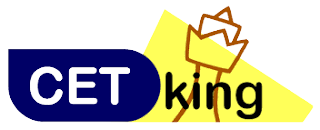Using a sketchpen in the CET exam has strategic advantages and using normal Pen has potential drawbacks, depending on how it’s used. One of the biggest benefits is that it allows candidates to write on the on-screen rough pad, just like using a notebook. This can be extremely helpful for solving mental based questions as mentioned below esp in verbal, Logic and Abstract. For puzzles, data interpretation sets, or complex quantitative problems where visualization and step-by-step solving are necessary normal pen is needed. For many students, this brings comfort and familiarity, similar to pen-and-paper practice. Another underrated advantage is the psychological benefit—simply holding the sketchpen in your non-dominant hand (e.g., left hand if you’re right-handed) can signal your brain that it’s problem-solving time. This can improve mental focus, especially when solving questions mentally and obviously save time.
Over-dependence on the normal pen can be counterproductive. Relying on it for every small calculation or step can lead to unnecessary scribbling, which wastes precious time in a speed-based exam like CET. Students often lose valuable seconds writing what could have been mentally calculated. The key is to use the sketchpen smartly—only when rough work is not essential. For straightforward or mental calculations, it’s better to skip scribbling. Strategic use of the sketchpen can boost efficiency and help maintain momentum during the exam. But students have to be vary of the invigilator they might stop you as they might think you are damaging the screen.
| Topic | Details | Importance | Sketchpen |
| Traditional Logic | Number Series | 2 | Sketchpen |
| Modern Logic | Alphanumeric Series | 3 | Sketchpen |
| Modern Logic | Analogy | 2 | Sketchpen |
| Modern Logic | Alphabed Tests | 2 | Sketchpen |
| Modern Logic | Odd man out | 2 | Sketchpen |
| Modern Logic | Classification | 2 | Sketchpen |
| Modern Logic | Logical Sequence of words | 1 | Sketchpen |
| Modern Logic | Cube based | 1 | Sketchpen |
| CR | Arguments | 3 | Sketchpen |
| CR | Cause Effect | 3 | Sketchpen |
| CR | Assumptions | 1 | Sketchpen |
| CR | Course of Action | 1 | Sketchpen |
| CR | Inference | 1 | Sketchpen |
| Series based | Series Completion | 10 | Sketchpen |
| Series based | Analogy | 3 | Sketchpen |
| Series based | Classification | 2 | Sketchpen |
| Modern Abstract | Cube & Dices | 2 | Sketchpen |
| Modern Abstract | Embedded Figures | 2 | Sketchpen |
| Modern Abstract | Paper Cutting Folding | 2 | Sketchpen |
| Modern Abstract | Mirror Water Image | 2 | Sketchpen |
| Modern Abstract | Figure Formation | 1 | Sketchpen |
| Vocabulary | Vocabulary – Synonyms | 4 | Sketchpen |
| Vocabulary | Vocabulary – Antonyms | 4 | Sketchpen |
| Vocabulary | One Word Substitution | 3 | Sketchpen |
| Vocabulary | Vocab Spelling | 2 | Sketchpen |
| Vocabulary | Analogies | 2 | Sketchpen |
| Vocabulary | Odd Man Out | 3 | Sketchpen |
| Vocabulary | Fill in the Blanks | 1 | Sketchpen |
| Grammar | Sentence Improvement | 4 | Sketchpen |
| Grammar | Error Detection | 4 | Sketchpen |
| Grammar | Idioms | 3 | Sketchpen |
| Reading Based | Reading Comprehension | 17 | Sketchpen |
| Reading Based | Para Jumbles | 2 | Sketchpen |
| Reading Based | Odd Man Out | 1 | Sketchpen |

